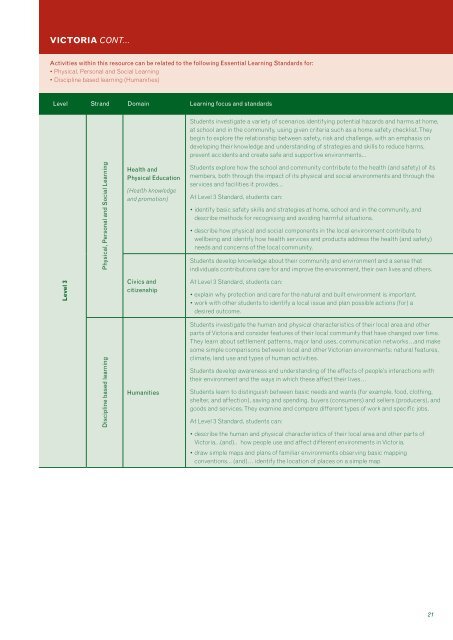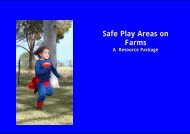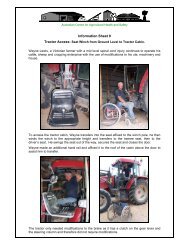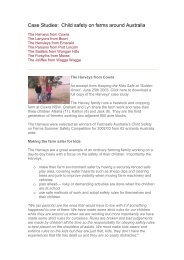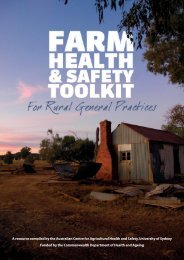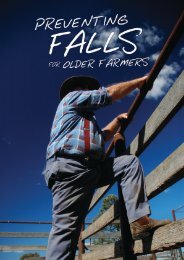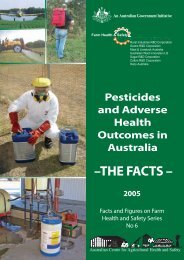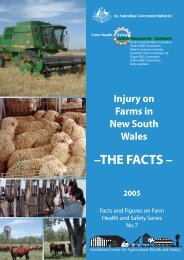VICTORIAActivities within this <strong>resource</strong> can be related to the following Essential Learning Standards <strong>for</strong>:• Physical, Personal and Social Learning• Discipline based learning (Humanities)Level Strand Domain Learning focusPhysical, Personal andSocial LearningHealth andPhysical Education(Health knowledgeand promotion)Civics andcitizenshipStudents learn to identify those environments where they feel confident and those where theymay be afraid or concerned <strong>for</strong> their safety. They practice how to respond to situations that makethem feel unsafe, and learn about who can help them. They learn about local signs and symbolsrelated to safety and explore possible actions to take when they feel threatened or unsafe.Students explore their emotions and identify the different ways in which people express andrespond to emotions.Students learn about…and compare classroom and family rules and other rules that theyknow…Students explore their responsibilities and rights and those of others in familiar contexts.Level 1Discipline based learningHumanitiesStudents draw on their own experience to help them understand the world around them.Through activities such as…examining photographs…and visits from community members,they learn about the concepts of…change and continuity.Through narratives, personal stories and celebrations students begin to learn about thecultures and histories that have contributed to <strong>Australian</strong> society and by seeing and hearingabout other places outside their experience they begin to consider how and why other timesand places are different from their own.Students develop spatial awareness through structured experiences within their immediateenvironment. They investigate the relative location, direction and distance of their home,school…and other significant features of their environment and begin to understand thegeography of their local area…They draw simple pictorial maps from their developing mentalmaps of familiar environments. Students explore how and why natural factors…and humanactivities…affect their lives.Physical, Personal and Social LearningHealth andPhysical Education(Health knowledgeand promotion)Civics andcitizenshipStudents begin to identify the benefits of safe behaviours and learn how they can protect andincrease their health and safety and the health and safety of others. In considering personalsafety issues, they discuss the way various situations and behaviours affect the way theyfeel, and develop personal responses to such behaviours and situations.Students explore people’s needs at various stages of development and recognise that someneeds apply to all stages of life.Students identify the range of groups to which they, their family members and their classbelong...They explore the roles, rights and responsibilities of various family and communitymembers. They discover why groups and communities have rules, begin to question rules whichthey believe are unfair, and make suggestions about improving the rules within the community.Students investigate the ways individuals, families, groups and communities can work toimprove their environment.Level 2Discipline based learningHumanitiesStudents develop their awareness of spatial concepts and use terms that demonstrate anunderstanding of absolute and relative locations. With guidance, they recognise and pointto their (home) on an appropriate map. They recognise…and can locate Australia and otherplaces with which they have links. Students learn to identify and name physical featuresand distinguish them on the basis of variables, including size (scale/height/distribution) andcolour. Through observation, they investigate and describe elements of the natural and builtenvironments in their local area. Students think about environmental differences, locally andin other parts of Australia…and why these differences exist.Students begin to grasp the role and importance of the various cultural groups that makeup the <strong>Australian</strong> community, including Aboriginal and Torres Strait Islander communities.They explore what their local area might have looked like be<strong>for</strong>e European settlement.Students are introduced to the concept of <strong>resource</strong>s and their management, and beginto understand how <strong>resource</strong> use reflects community interdependence and sustainability.They begin to understand how local <strong>resource</strong>s are used to make products which meet localpeople’s needs and the needs of people in other places...20
VICTORIA CONT...Activities within this <strong>resource</strong> can be related to the following Essential Learning Standards <strong>for</strong>:• Physical, Personal and Social Learning• Discipline based learning (Humanities)Level Strand Domain Learning focus and standardsStudents investigate a variety of scenarios identifying potential hazards and harms at home,at school and in the community, using given criteria such as a home safety checklist. Theybegin to explore the relationship between safety, risk and challenge, with an emphasis ondeveloping their knowledge and understanding of strategies and skills to reduce harms,prevent accidents and create safe and supportive environments...Physical, Personal and Social LearningHealth andPhysical Education(Health knowledgeand promotion)Students explore how the school and community contribute to the health (and safety) of itsmembers, both through the impact of its physical and social environments and through theservices and facilities it provides...At Level 3 Standard, students can:• identify basic safety skills and strategies at home, school and in the community, anddescribe methods <strong>for</strong> recognising and avoiding harmful situations.• describe how physical and social components in the local environment contribute towellbeing and identify how health services and products address the health (and safety)needs and concerns of the local community.Students develop knowledge about their community and environment and a sense thatindividuals contributions care <strong>for</strong> and improve the environment, their own lives and others.Level 3Civics andcitizenshipAt Level 3 Standard, students can:• explain why protection and care <strong>for</strong> the natural and built environment is important.• work with other students to identify a local issue and plan possible actions (<strong>for</strong>) adesired outcome.Discipline based learningHumanitiesStudents investigate the human and physical characteristics of their local area and otherparts of Victoria and consider features of their local community that have changed over time.They learn about settlement patterns, major land uses, communication networks…and makesome simple comparisons between local and other Victorian environments: natural features,climate, land use and types of human activities.Students develop awareness and understanding of the effects of people’s interactions withtheir environment and the ways in which these affect their lives…Students learn to distinguish between basic needs and wants (<strong>for</strong> example, food, clothing,shelter, and affection), saving and spending, buyers (consumers) and sellers (producers), andgoods and services. They examine and compare different types of work and specific jobs.At Level 3 Standard, students can:• describe the human and physical characteristics of their local area and other parts ofVictoria...(and).. how people use and affect different environments in Victoria.• draw simple maps and plans of familiar environments observing basic mappingconventions... (and)… identify the location of places on a simple map21


